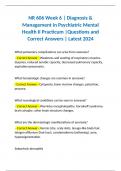NR 606 Week 6 | Diagnosis &
Management in Psychiatric Mental
Health II Practicum |Questions and
Correct Answers | Latest 2024
What pulmonary complications can arise from anorexia?
- Correct Answer - Weakness and wasting of respiratory muscles,
dyspnea, reduced aerobic capacity, decreased pulmonary capacity,
aspiration pneumonia.
What hematologic changes are common in anorexia?
- Correct Answer - Cytopenia, bone marrow changes, petechiae,
purpura.
What neurological conditions can be seen in anorexia?
- Correct Answer - Wernicke encephalopathy, Korsakoff syndrome,
brain atrophy, other brain structure changes.
What are the dermatologic manifestations of anorexia?
- Correct Answer - Xerosis (dry, scaly skin), lanugo-like body hair,
telogen effluvium (hair loss), carotenoderma (yellowing), acne,
hyperpigmentation.
Seborrheic dermatitis
,- Correct Answer - Erythema and greasy scales on the skin
Acrocyanosis - Correct Answer - Cold, blue, and occasionally sweaty
hands or feet
Perniosis - Correct Answer - Painful or pruritic erythema
Petechiae - Correct Answer - Small red or purple spots on the skin
Livedo reticularis - Correct Answer - Reddish-cyanotic circular
patches on the skin
Paronychia - Correct Answer - Inflammation of the nail folds
Pruritus - Correct Answer - Itching sensation on the skin
Striae distensae - Correct Answer - Linear patches on the skin
Slower wound healing - Correct Answer - Delayed healing of wounds
Binge eating/purging type anorexia nervosa - Correct Answer - Eating
disorder involving purging activities to control weight gain
,What are the compensatory behaviors in bulimia nervosa? - Correct
Answer - Self-induced vomiting, laxative use, excessive exercise,
fasting.
What is the prevalence rate of bulimia nervosa in women? - Correct
Answer - Up to 1.5%.
What is the prevalence rate of bulimia nervosa in men? - Correct
Answer - Unknown.
Has the prevalence of bulimia nervosa increased over time? - Correct
Answer - Yes.
What are common comorbidities with bulimia nervosa? - Correct
Answer - Depression, anxiety, substance use disorder.
What percentage of individuals with bulimia nervosa have
personality disorders? - Correct Answer - Unknown.
What is the most common personality disorder associated with
bulimia nervosa? - Correct Answer - Borderline personality disorder.
What are the diagnostic criteria for bulimia nervosa according to
DSM-5-TR? - Correct Answer - Recurrent binge eating, lack of control,
compensatory behaviors, weekly occurrence for 3 months, influence
of body shape/weight on self-evaluation.
, What are the medical complications of bulimia nervosa? - Correct
Answer - N/A
What are the medical complications of bulimia? - Correct Answer -
Dental, Endocrine, Gastrointestinal, Renal & Electrolytes
What are the dental complications of bulimia? - Correct Answer -
Enamel erosion, Hot/cold sensitivity, Discoloration, Dental caries,
Gum disease
What are the endocrine complications of bulimia? - Correct Answer -
Menstrual irregularities, Osteopenia and osteoporosis, Diabetes
What are the gastrointestinal complications of bulimia? - Correct
Answer - Parotid and submandibular (salivary) gland hypertrophy,
Laryngopharyngeal reflux, Loss of gag reflex, Esophageal dysmotility,
Abdominal pain and bloating, Mallory-Weiss syndrome (esophageal
tears), Esophageal rupture (Boerhaave syndrome), Gastroesophageal
reflux disease (GERD), Barrett's esophagus, Gastric dilation, Diarrhea
and malabsorption, Steatorrhea, Protein-losing gastroenteropathy,
Hypokalemic ileus, Colonic dysmotility, Constipation, Irritable bowel
syndrome, Melanosis coli, Cathartic colon, Rectal prolapse,
Pancreatitis
What are the renal and electrolyte complications of bulimia? -
Correct Answer - Dehydration, Hypokalemia, Hypochloremia,
Hyponatremia, Metabolic alkalosis, Hypomagnesemia,
Hypophosphatemia





